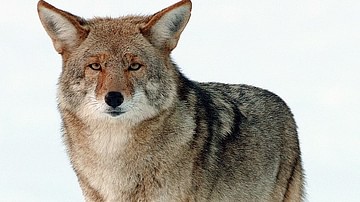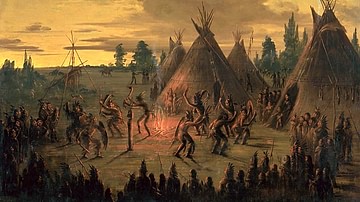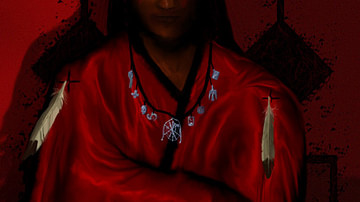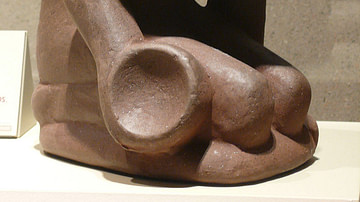Coyote tales of the Comanche feature the same trickster figure as the Coyote tales of the Shasta nation, the Coyote tales of the Apache, and those of many other Native peoples of North America. Coyote, the most famous trickster figure of Native American lore, appears in the stories of many different nations, usually as the main character, encouraging transformation.

Sometimes he plays a supporting role in the stories, but even then, Coyote serves as an agent of change. This change can be as simple as teaching the White Man how easy it is to be cheated (as in A Trickster Tale, below) or as dramatic as trying to divide the sun between the daytime animals and nighttime animals (Why the Bear Waddles When He Walks) or, sometimes, it is the trickster who is tricked, as in The Eye-Juggler. Even in stories where Coyote loses – or dies – the story emphasizes the concept of life-as-change. As with the Coyote tales of other nations, the Coyote tales of the Comanche are among the most popular.
Comanche History & Culture
Comanche is the Spanish version of an Ute word for "enemy" (kimantsi or kohmahts); the Comanche refer to themselves as Numunuh ("the People"). They were originally associated with the Eastern Shoshone (Shoshoni) nation of the Great Basin and were a hunter-gatherer society but differed from many others in that women, as well as men, hunted. The Comanche believe in a single Supreme Being, Pahah (Paha), Creator and Sustainer of Life, who is helped by various spirits, each with their own sphere of responsibility. As with other Native American nations, the Comanche also hold that the universe is inhabited by many unseen entities which sometimes make themselves known and walk among the people, including Coyote.
Eventually, those who became known as Comanche broke off from the Shoshone and migrated south to the regions of modern-day Colorado, Kansas, New Mexico, Oklahoma, and Texas, which became known as Comancheria ("Land of the Comanche") by c. 1770. The Comanche are understood as the first Native Americans to fully master and utilize the horse, and, by 1795, they were breeding and selling horses. They became as well-known for their horses as for their warriors and skill in warfare.
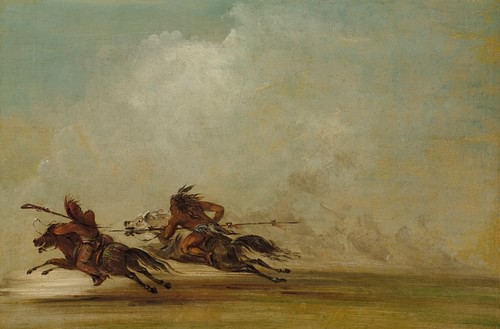
During the Comanche Wars (1706-1875), the Comanche fought off incursions by Spanish, Mexican, and Euro-American forces while conducting raids against their settlements. The Comanche increased in wealth and power through warfare and trade in slaves and horses and, most likely, would have continued to hold off the Euro-American expansion of the 19th century if not for outbreaks of smallpox, measles, and cholera in 1817 and 1848, which killed over half the population.
Their resistance, already weakened by these losses, was broken in 1874 after their defeat (along with their Arapaho, Cheyenne, and Kiowa allies) at the Battle of Palo Duro Canyon and then the destruction of at least 1,500 Comanche horses by order of Colonel Ranald Mackenzie of the US Army. The Comanche surrendered in 1875 and were relocated to Indian Territory (modern-day Oklahoma).
Their best-known chief, Quanah Parker (l. c. 1845-1911), son of Cynthia Ann Parker, a Euro-American captured as a girl by the Comanche, worked to maintain the traditional culture while accommodating the demands of the US government. He argued for freedom of religion for his people in maintaining the Native American Church and its use of peyote in rituals as well as the maintenance of the Comanche language and culture. His efforts were continued by others, and, today, Comanche culture, language, and religion remain intact, including their stories like the three given below.
Coyote tales of the Comanche are similar to the Coyote tales of other nations, and there is considerable borrowing between their tales and those of the Apache in particular. The same is true of many Native American trickster figures, however, and a reader acquainted with Manabozho tales of the Ojibwe, Glooscap tales of the Wabanaki Confederacy, the Iktomi tales of the Sioux, or Wihio tales of the Cheyenne will recognize the same themes of transformation, illusion vs. reality, and the shifting roles of the central character in the Comanche Coyote tales.
Text
The following come from Shoshone and Comanche Tales (1909) by H. H. St. Clair, edited by R. H. Lowie (A Trickster Tale and The Eye-Juggler) republished in 2025, and from American Indian Mythology (1970) by Alice Marriott and Carol K. Rachlin (Why the Bear Waddles When He Walks).
A Trickster Tale
One white man had heard a great deal about Coyote's trickery. He said, "Oh, I want to see him! Did you ever hear of any person getting cheated right before his eyes? Go, bring him here. I'll see whether he can beat me that way."
Coyote was walking along a short distance away. One of them spied him. "There is Coyote, who always cheats everybody."
The white man got out of his carriage to look at him. He put on very fine clothes, mounted a good horse, and loped after Coyote until he caught up to him.
"Hold on, my friend. I have heard how you always cheat people."
Coyote answered, "Oh, you are mistaking me for someone else."
"Oh, no. Go ahead. Cheat me out of something."
Coyote said, "My stuff for scheming is not here."
"Where is it, then, the stuff you cheat people with?"
"I have it at my house."
"Well, go fetch it and fool me!"
Coyote said, "Lend me your horse."
"Where is your house?"
"Just over the hill."
The white man dismounted and lent him his horse. The horse was afraid of Coyote. Coyote said, "Give me all your clothes or he will be afraid of me."
So, the white man gave Coyote all his clothes. Coyote put them on, mounted, and loped off, saying, "I have fooled you already. You certainly are easily cheated."
The white man stood there, waving to him to return; but Coyote did not mind him and galloped away.
Why the Bear Waddles When He Walks
In the beginning days, nobody knew what to do with the sun. It would come up and shine for a long time. Then it would go away for a long time and everything would be dark.
The daytime animals naturally wanted the sun to shine all the, so they could live their lives without being interrupted by the dark. The nighttime animals wanted the sun to go away forever, so they could live the way they wanted to.
At last, they all got together to talk things over.
Old Man Coyote said, "Let's see what we can do about that sun. One of us ought to have it or the other side ought to get rid of it."
"How will we do that?" Scissor-tailed Flycatcher asked. "Nobody can tell the sun what to do. He's more powerful than anyone else in the world."
"Why don't we play hand game for it?" Bear asked. "The winning side can keep the sun or throw it away, depending on who wins and what they want to do with it."
So, they got out the guessing bones to hide in their hands and they got out the crow-feathered wands for the guessers to point with and they got out the twenty painted dogwood sticks for the umpires to keep score with. Coyote was the umpire for the day side and nighttime umpire was Owl.
The umpires got a flat rock, like a table, and laid out their counting sticks on that. Then, the two teams brought logs and lined them up facing one another, with the umpires and their flat rock at one end, between the two teams.
That was a long hand game. The day side held the bones first, and they were so quick and skillful passing them from hand to hand behind their backs and waving them in the guessers' faces that it seemed surely, they must win. Then Mole, who was guessing for the night side, caught both Scissor-tail and Hawk at the same time, and the bones went to the night side, and the day people began to guess.
Time and again, the luck went back and forth, each team seeming to be about to beat the other. Time and again, the luck changed, and the winning team became the losing one.
The game went on and on. Finally, the sun, waiting on the other side of the world to find out what was going to happen to him, got tired of it all.
The game was so long that Bear got tired, too. He was playing on the night side. He got cramped sitting on the log, and his legs began to ache. Bear took off his moccasins to rest his feet, and still the game went on and on.
At last, the sun was so bored that he decided to go and see for himself what was happening. He yawned and stretched and crawled out of his bed on the underneath side of the world. He started to climb up his notched ladder to the top side, to find out what was happening.
As the sun climbed, the light grew stronger, and the night people began to be afraid. The game was still even; nobody had won. But the sun was coming and coming, and the night animals had to run away. Bear jumped up in such a hurry that he put his right foot in his left moccasin, and he left foot in his right moccasin.
The sun was full up now, and all the other night animals were gone. Bear went after them as fast as he could in his wrong moccasins, rocking and waddling from side to side, and shouting, "Wait for me! Wait for me!"
But nobody stopped or waited, and Bear had to go waddling along, just the way he has done ever since.
And, because nobody won the game, the day and night took turns from that time on. Everybody had the same time to come out and live his life the way he wanted to as everybody else.
The Eye-Juggler
Coyote was knocking about hunting for something. He came to a creek where there was nothing but green willows. Two little yellow birds were playing there. He came up to them. Laughing, they pulled out their eyes and threw them on the trees while they stood below.
"Eyes, fall!" they said. Then their eyes fell back into their sockets.
Coyote went to them. He greatly admired their trick.
"O, brothers! I wish to play that way too."
"Oh, we won't show you. You are too mean. You would throw your eyes into any kind of a tree and lose them."
"Oh, no! I would do it just like you."
At last, the birds agreed to show him. They pulled out his eyes, threw them up, and said, "Eyes, fall!" Then his eyes fell back again. Coyote was well pleased. He pulled out his eyes himself, threw them up, and said, "Eyes, fall!" They returned to their places.
"Let us all go along this creek!" said the birds. "Other people will see us and take a fancy to us."
They went along playing. Coyote said, "I am going over there. I know the trick well now."
He left them. He got to another creek. A common willow tree was standing there.
"There is no need to be afraid of this tree. I'll try it first." He pulled out his eyes and threw them at the tree. "Eyes, fall!" he shouted. His eyes did not fall. He thus became blind. He tied something around his eyes and left.
Walking along the creek, he met two young girls.
"What kind of girls are you?"
"We are Ya'yaru girls."
"We all belong to the same people, then; I am a Ya`yaru young man."
The two girls did not know he was blind.
He asked them, "Where are you going?"
"We are going over there."
"Well, we will all go together."
They debated the matter, then all went together.
One girl said, "Just look at the buffalo there!"
Coyote laughed and said, "I was wondering how soon you would catch sight of them, that's why I would not tell you about them."
When they had gone a little father, one of the girls asked the other, "Why does he not kill one of those buffalo for us?"
Coyote laughed, "I was wondering how long it would take you to think of that. That's why I would not tell you before. Go around that way to the other side of the buffalo, then they won't see you. Then they will run here I will kill one for us."
They followed his directions. The buffalo, seeing them ran towards Coyote. When they came nearer, he shot at them and killed one by chance.
When the girls ran up, they said, "He has really killed one!" They were skinning and cutting up the buffalo. One of the girls exclaimed, "Oh, isn't he fat!" And Coyote said, "Why, certainly. I was looking for a fat one. I strained my eyes mightily hunting for a fat one."
The two girls said, "Doesn't he know well how to look for a fat one?"
Coyote said, "Do you two cut it up. I will build us a house by the creek."
He went off to make them a lodge. There were big holes in it everywhere because he was blind. He made it of brush. The two girls came with the meat. They said, "This must be a house built by a blind man. There are holes all over."
Coyote laughed. "Oh, you two don't understand. Why, I built it this way on purpose so that if lots of enemies charge on us, we might go out in any direction. There is no danger here of our being hemmed in."
The girls said, "We did not think of that."
They made their home there, both becoming Coyote's wives.
One day, Coyote said to them, "Louse me" [because he needed them to pick out his lice].
The girls sat down, and Coyote placed his head on one and his feet on the other. For a while, they loused him, then he fell asleep.
One of the girls said, "Let us pull off this rag from his head. He won't know anything about it, he's asleep. Let us look at his eyes."
She raised the cover. "Why, he is blind! There are lots of worms in his eyes."
The one on whose lap his head was resting bade her companion bring a stump with lots of ants on it.
"Put it under his head and fetch another one without ants for his feet."
After they had fixed the stumps, one of them said, "Let us go now."
The older sister said, "Take hold of those bells!"
They got some distance away from Coyote. Shortly after they had left, the ants began to bite him. He began butting with his head.
"Oh, be easy, you two, just louse me!" He tried to butt them but only struck the ground. He woke up and looked for their trail.
Looking back, the girls saw him coming. They began to run.
"That is surely Coyote there. Let us beat him by that big red bluff."
The older sister said, "Tear off those bells of yours." She pulled them off. "He can't see us, he is just following the bells. When we get to the red bluff, drop your bells and he will fall over it."
Coyote was pursuing them. The girls' bells were jingling as they ran along. When they got to the cliff, they dropped them. Coyote, hearing the bells, followed after them and over the cliff, where he was crushed to pieces. The girls then went home.

